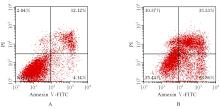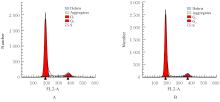| 1 |
KANAI Y, SEGAWA H, et al. Expression cloning and characterization of a transporter for large neutral amino acids activated by the heavy chain of 4F2 antigen (CD98)[J]. J Biol Chem, 1998, 273(37): 23629-23632.
|
| 2 |
SUN Y M, WEN J J, XU T, et al. Reduction of peritoneal cavity B1a cells in adult SLC7A5 knockdown mice via dysregulating the mTOR pathway[J]. Int Immunopharmacol, 2023, 117: 109939.
|
| 3 |
PRASAD P D, WANG H, HUANG W, et al. Human LAT1, a subunit of system L amino acid transporter: molecular cloning and transport function[J]. Biochem Biophys Res Commun, 1999, 255(2): 283-288.
|
| 4 |
KANAI Y. Amino acid transporter LAT1 (SLC7A5) as a molecular target for cancer diagnosis and therapeutics[J]. Pharmacol Ther, 2022, 230: 107964.
|
| 5 |
ZHU Q N, WANG J, SHI Y N, et al. Bioinformatics prediction and in vivo verification identify SLC7A5 as immune infiltration related biomarker in breast cancer[J]. Cancer Manag Res, 2022, 14: 2545-2559.
|
| 6 |
SEKINE M, KOH I, NAKAMOTO K, et al. Selective inhibition of L-type amino acid transporter 1 suppresses cell proliferation in ovarian clear cell carcinoma[J]. Anticancer Res, 2023, 43(6): 2509-2517.
|
| 7 |
SIDORKIEWICZ I, JÓŹWIK M, BUCZYŃSKA A, et al. Identification and subsequent validation of transcriptomic signature associated with metabolic status in endometrial cancer[J]. Sci Rep, 2023, 13(1): 13763.
|
| 8 |
ZHANG J S, XU Y, LI D D, et al. Review of the correlation of LAT1 with diseases: mechanism and treatment[J]. Front Chem, 2020, 8: 564809.
|
| 9 |
张京顺. SLC7A5在大鼠多囊卵巢综合征模型卵巢上的表达及其功能研究[D]. 长春: 吉林大学, 2021.
|
| 10 |
肖晓青, 邱思花, 谢 芳, 等. 多模态子宫输卵管超声造影评估输卵管堵塞性病变的诊断价值[J]. 中国医学物理学杂志, 2023, 40(10): 1246-1250.
|
| 11 |
许 川, 舒为群, 张 亮, 等. 大鼠卵巢颗粒细胞的原代培养与鉴定[J]. 癌变·畸变·突变, 2009, 21(3): 234-237.
|
| 12 |
李婉玉, 郑 喜. 血清及卵泡液AMH水平检测在辅助生殖领域中的应用研究进展[J]. 延边大学医学学报, 2023, 46(4): 347-350.
|
| 13 |
付璐璐. 多囊卵巢综合征动物模型卵巢中的mRNA/lncRNA表达谱及相关功能的研究[D]. 长春: 吉林大学, 2018.
|
| 14 |
STRINGER J M, ALESI L R, WINSHIP A L, et al. Beyond apoptosis: evidence of other regulated cell death pathways in the ovary throughout development and life[J]. Hum Reprod Update, 2023, 29(4): 434-456.
|
| 15 |
CACCIOTTOLA L, CAMBONI A, CERNOGORAZ A, et al. Role of apoptosis and autophagy in ovarian follicle pool decline in children and women diagnosed with benign or malignant extra-ovarian conditions[J]. Hum Reprod, 2023, 38(1): 75-88.
|
| 16 |
KASHI O, MEIROW D. Overactivation or apoptosis: which mechanisms affect chemotherapy-induced ovarian reserve depletion?[J]. Int J Mol Sci, 2023, 24(22): 16291.
|
| 17 |
GONG Y, LUO S, FAN P, et al. Growth hormone activates PI3K/Akt signaling and inhibits ROS accumulation and apoptosis in granulosa cells of patients with polycystic ovary syndrome[J]. Reprod Biol Endocrinol, 2020, 18(1): 121.
|
| 18 |
JIANG X L, TAI H, XIAO X S, et al. Cangfudaotan decoction inhibits mitochondria-dependent apoptosis of granulosa cells in rats with polycystic ovarian syndrome[J]. Front Endocrinol, 2022, 13: 962154.
|
| 19 |
LLIBEROS C, LIEW S H, ZAREIE P, et al. Evaluation of inflammation and follicle depletion during ovarian ageing in mice[J]. Sci Rep, 2021, 11(1): 278.
|
| 20 |
YE H Y, SONG Y L, YE W T, et al. Serum granulosa cell-derived TNF-α promotes inflammation and apoptosis of renal tubular cells and PCOS-related kidney injury through NF-κB signaling[J]. Acta Pharmacol Sin, 2023, 44(12): 2432-2444.
|
| 21 |
D’ARCY M S. Cell death: a review of the major forms of apoptosis, necrosis and autophagy[J]. Cell Biol Int, 2019, 43(6): 582-592.
|
| 22 |
SPERANSKII A I, KOSTYUK S V, KALASHNIKOVA E A, et al. Enrichment of extracellular DNA from the cultivation medium of human peripheral blood mononuclears with genomic CpG rich fragments results in increased cell production of IL-6 and TNF-a via activation of the NF-kB signaling pathway[J]. Biomed Khim, 2016, 62(3): 331-340.
|
| 23 |
贺鹏翼, 董 宁, 吴 瑶, 等. 脓毒症小鼠脾脏树突状细胞焦亡及其对炎症反应和免疫功能的影响[J]. 解放军医学杂志, 2023, 48(5): 537-544.
|
| 24 |
ZHAO X Q, LIN Y, JIANG B J, et al. Icaritin inhibits lung cancer-induced osteoclastogenesis by suppressing the expression of IL-6 and TNF-a and through AMPK/mTOR signaling pathway[J]. Anti Cancer Drugs, 2020, 31(10): 1004-1011.
|
| 25 |
JUNG H, LEAL-EKMAN J S, LU Q H, et al. Atg14 protects the intestinal epithelium from TNF-triggered villus atrophy[J]. Autophagy, 2019, 15(11): 1990-2001.
|
| 26 |
MAZUMDER S, PLESCA D, ALMASAN A. Caspase-3 activation is a critical determinant of genotoxic stress-induced apoptosis[J]. Methods Mol Biol, 2008, 414: 13-21.
|
| 27 |
肖丽君, 甘苡榕, 刘春丽, 等. 大黄灵仙方对胆固醇结石豚鼠模型胆囊Cajal间质细胞中scf/c-kit信号通路的影响[J]. 临床肝胆病杂志, 2023, 39(2): 376-382.
|
| 28 |
HONNMA H, ENDO T, HENMI H, et al. Altered expression of Fas/Fas ligand/caspase 8 and membrane type 1-matrix metalloproteinase in atretic follicles within dehydroepiandrosterone-induced polycystic ovaries in rats[J]. Apoptosis, 2006, 11(9): 1525-1533.
|
| 29 |
LIU Y, ZHAI J J, CHEN J, et al. PGC-1α protects against oxidized low-density lipoprotein and luteinizing hormone-induced granulosa cells injury through ROS-p38 pathway[J]. Hum Cell, 2019, 32(3): 285-296.
|
 )
)










